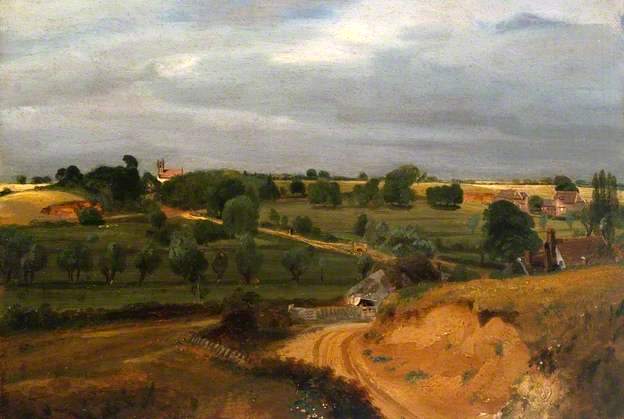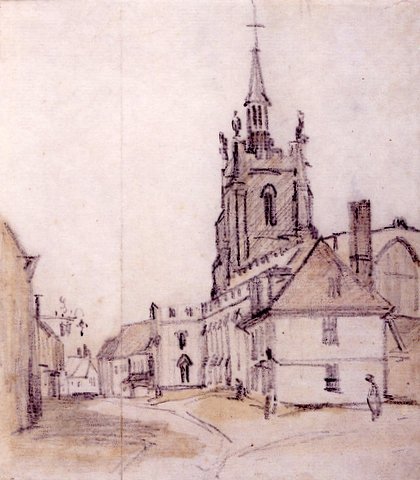CONSTABLE, John
John Constable was born at East Bergholt House, Church Street, East Bergholt, Suffolk on 11 June 1776, fourth of six children of Golding Constable (1739-1816), a merchant, mill owner, and gentleman farmer, and his wife Ann Watts (1748–1815), daughter of William Watts (c.1717–1773), a cooper. A frail infant hastily baptised on the night of his birth, but Constable nevertheless enjoyed a hearty childhood and about 1783, sent to boarding school in Ford Street, Essex, and then to Lavenham, Suffolk. Mistreated there by a brutal usher, Constable returned home and continued his education as a day boy at nearby Dedham grammar school whose headmaster, the Revd Thomas Grimwood, treated him with kindness and indulged his early interest in painting. Constable resisted family pressure to prepare for a career in the church and when it became apparent, that the disabilities of his elder brother Golding (1774-1838) would prevent his taking over from their father, Constable, at the age of sixteen, reluctantly began training in the family business. Although he would ultimately have had a managerial role in the diverse and substantial corn and coal trade established by Golding senior, Constable was exposed to the practical side of the milling business as well, working in his father's windmill on East Bergholt Heath, gauging the evanescent meteorological conditions, and familiarising himself with the navigable River Stour, with its watermills, locks, barges, towpaths, and adjacent fields, all of which were crucial to the family's prosperity. While employed, Constable continued to paint and draw, not professionally, but as a gentlemanly pursuit. Practical advice concerning materials and technique was provided by an amateur landscape painter, the local plumber and glazier John Dunthorne, who was Constable's frequent painting companion. Access to tuition of a different sort, as well as entrée into the higher echelons of the art world, were fortuitously managed by Constable's mother in 1795, when she arranged an introduction to Sir George Beaumont, 7th Bart. (1753-1827) then visiting his own mother at Dedham. In 1799, when Constable's sixteen-year-old younger brother Abram (1783-1862) was able to take his place in the family business, Constable left home with an allowance to study art in London. In February 1799, armed with a letter of introduction from author and philanthropist Priscilla Wakefield (1751-1832), Constable presented himself to Joseph Farington (1747-1821), an influential Royal Academician whose friendly intervention facilitated his entry into the London art world. In March he was admitted to the Royal Academy Schools as a probationer, restricted to drawing in the antique academy until February 1800, when enrolled as a student in the life academy. Although his life was now essentially London-based, Constable frequently returned to Suffolk, maintaining close contact with family and friends, but more importantly indulging his need to paint and draw from nature. Stimulated by parental pressure to achieve some degree of financial independence, Constable found it necessary to resort to portraiture, finding many of his sitters through family and friends but in 1809 they were still supplementing his meagre income and worried about his continued devotion to landscape painting. After ten years in London, he was making progress and had exhibited works at the Royal Academy and the British Institution. Constable first encountered Maria Elizabeth Bicknell (1788–1828) when, as a twelve-year-old child, she came to visit her maternal grandfather, Durand Rhudde, the wealthy rector of East Bergholt. She was the eldest of five children of Charles Bicknell, a solicitor to the Admiralty and the Prince Regent, and his second wife, Maria Elizabeth Rhudde. Dr Rhudde and his relentless intervention plagued the couple's seven-year courtship and for the next five years Constable continued to divide his time between London and East Bergholt, painting portraits for money but devoting himself to the landscape. The sudden death of his mother in 1815, and the death of his father after months of ill-health the following year, his share of the inheritance eased his financial worries and removed at least one of the barriers to his marriage and on 2 October 1816, Constable and Maria were married at St Martin-in-the-Fields, London when Constable, who had lived in bachelor's lodgings in at least six different locations in London since 1799, brought Maria to his rooms at 63 Charlotte Street where he had been living for five years. Within six months they moved to 1 Keppel Street, Bloomsbury, by which time she had already suffered a miscarriage, but their son John Charles (December 1817-1841) was born in 1817. Dr Rhudde bequeathed to Maria, the same portion as her siblings when he died in 1819 and with the interest he was receiving from his father's bequest, plus his annual share of the family business and Maria's small annuity from her father, Constable calculated that he would need to earn an additional £100–150 per year to cover their expenses. Maria gave birth to a daughter Maria Louisa (1819-1885), but his wife's health was a constant source of concern for Constable and in August 1819 he rented a cottage in Hampstead. The Stour Valley in Constable's life and art was important but from then until his death, his visits there were infrequent and of short duration. Maria was settled with the children in Hampstead, he needed to work in his Keppel Street studio, and although Hampstead provided an occasional second home where Maria could recuperate, the birth of their third child Charles Golding (1821-1879), and the imminent arrival of another Isabel (1822-1888) the following summer necessitated a larger London house and in June 1822, they moved to 35 Charlotte Street, Fitzroy Square which would remain his London home until his death in 1837. In 1824, Constable took lodgings for the family in Brighton, the first of several extended stays there, travelling down from London to be with them. While the English public dithered over Constable's work the French art world revelled in his freshness and apparent rejection of staid landscape conventions. Parisian dealer John Arrowsmith, having seen ‘The Hay Wain’ at the 1822 British Institution exhibition, purchased it in 1824 and commissioned several other paintings. An associate of the Royal Academy since 1819, Constable sought full membership on several occasions but failed. A fifth child was born in 1825 Emily (1825-1839), a sixth in 1826 Alfred Abram (1826-1853). Maria's consumption, compounded by so many pregnancies, was worsening; and in 1827, with Maria pregnant yet again with Lionel Bicknell, Constable transferred the family permanently to Hampstead where he leased 6 Well Walk, keeping only his studio and a few rooms in Charlotte Street for his own use. His financial worries were alleviated in 1828, by an inheritance of £20,000 from Maria's father, but she had little time to enjoy it for Maria died on 23 November, leaving Constable with seven children under the age of eleven. Constable, unlike many contemporary landscape painters, had little contact with the print publishing industry or the burgeoning illustrated-book trade and shortly after Maria's death he decided to have several of his paintings and sketches engraved, but he retained absolute control over the entire publishing venture. He engaged David Lucas (1802-1881) to engrave 'Various Subjects of Landscape, Characteristic of English Scenery' (known as English Landscape), published between 1830 and 1832 in five separate parts and reissued in 1833 with several pages of letterpress text, it contained twenty-two mezzotints, all of which progressed from first proof to published state amid much dithering and petulance on Constable's part. In 1836 he was elected a member of both the Royal Institution and the Graphic Society. On the evening of 31 March 1837, after returning to Charlotte Street from a charitable errand, he became ill, suffering from giddiness and sickness during the night. John Constable died in the early hours of 1 April and despite a post-mortem the cause of death was not determined. Constable was buried beside his wife in the churchyard of St John's, Hampstead, and left an estate valued at £25,000 to his seven children, all of whom were still minors. Several of Constable's children possessed artistic ability, particularly the youngest, Lionel Bicknell, whose works were for many years misattributed to his father.
Royal Academy Exhibits
from
1803 59 A Study from Nature
from 3 Spur Street, Leicester Square
1806 787 His Majesty's ship, Victory, Capt. E Harvey, in the memorable Battle of Trafalgar
from 13 Percy Street
1807 52 View in Westmoreland
98 Keswick Lake
150 Bow Fell, Cumberland
1808 52 Winander-meer lake
100 A Scene in Cumberland
103 Borrowdale
1809 26 A Landscape
28 A Landscape
183 A Landscape
from 49 Frith Street, Soho
1810 74 A Landscape
116 A Church Yard
1811 71 Twilight
471 Dedham Vale, morning
from 63 Upper Charlotte Street, Fitzroy Square
1812 9 A Water Mill
72 Landscape, Evening
133 Landscape, a recent shower
372 Salisbury, morning
1813 266 Landscape, boys fishing
325 Landscape, morning
1814 28 Landscape, ploughing scene Suffolk
261 Landscape, the Ferry
1815 20 A View of Dedham
146 Landscape, a sketch
215 Boat Building
268 Village in Suffolk
310 Landscape
415 A Drawing
446 A Drawing
510 A Drawing
1816 169 The Wheat Field
298 A Wood: Autumn
1817 85 Wivenhoe Park, Essex: the Seat of Major-General Rebow
141 A Cottage
216 Portrait of Rev. J. Fisher
255 Scene on a Navigable River
from 1 Keppell Street, Russell Square, London
1818 11 Landscape: Breaking up of a Shower
34 Landscape
142 Landscape: A Study
304 Landscape: A Study
446 A Gothic Porch
483 Elms
1819 251 A Scene on the River Stour
1820 17 Landscape
148 Harwich Lighthouse
1821 89 Hampstead Heath
132 A Shower
135 Harrow
339 Landscape: Noon
1822 111 Hampstead Heath
183 View of the River Stour, Dedham
219 Malvern Hall, Warwickshire
295 View from the Terrace, Hampstead
314 A Study of Trees from Nature
from 35 Upper Charlotte Street, Fitzroy Square
1823 59 Salisbury Cathedral, from the Bishop's Gardens
179 Study of Trees: A Sketch
244 A Cottage
1824 180 A Boat passing a Lock
1825 115 Landscape
186 Landscape
224 Landscape
1826 122 A Mill at Gillingham, in Dorsetshire
225 Landscape
1827 48 Mill, Gillingham, Dorset
186 Chain Pier, Brighton
290 Hampstead Heath
1828 7 Landscape
232 Landscape
1830 19 Dell Scene, in the Park of the Right Hon. the Countess of Dysart, at Helmingham, Suffolk
94 Landscape
248 A Heath
1831 123 Yarmouth Pier
169 Salisbury Cathedral, from the Meadows
1832 142 Sir Richard Steele's Cottage, Hampstead
152 A Romantic House, Hampstead
279 Waterloo Bridge, from Whitehall Stairs, June 18th 1817
286 Moonlight
492 Jaques and the Wounded Stag
632 A Church
643 A Mill
644 Farm-house
1833 34 Englefield House, Berkshire, the seat of Richard Benyon de Bouvoir, Esq.
94 A Heath, showery: Noon
344 Cottage in a Corn-field
402 Landscape: Sunset
639 An Old Farm-house
645 A Miller's House
647 A Windmill: Squally Day
1834 481 The Mound of the city of Old Sarum, from the South
548 Study of Trees, made in the grounds of Charles Hotford, Esq. at Hampstead
582 Stoke Poges Church, near Windsor, the Scene of Gray's Elegy
686 From Gray's Eleg, stanza II
1835 145 The Valley Farm
1836 9 Cenotaph to the Memory of Sir Joshua Reynolds...Coleorton Hall, Leicestershire
581 Stonehenge
the late
1837 193 Arundel Mill and Castle
Works by This Artist

|
Brightwell Church and Village (Suffolk)Oil on wood
|

|
St Peter's Church, Sudbury, from the south-eastPencil and wash
|